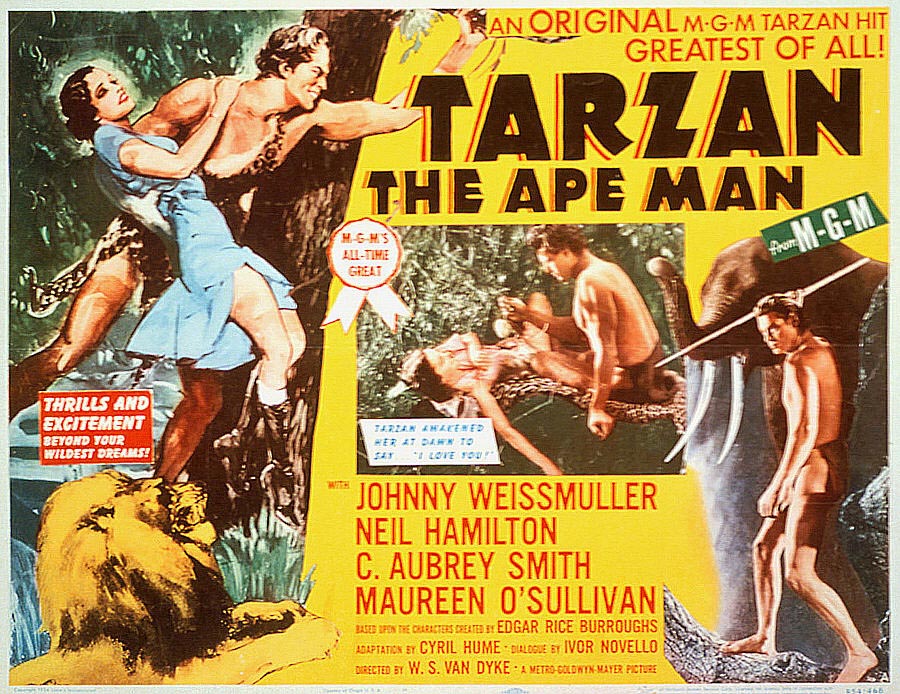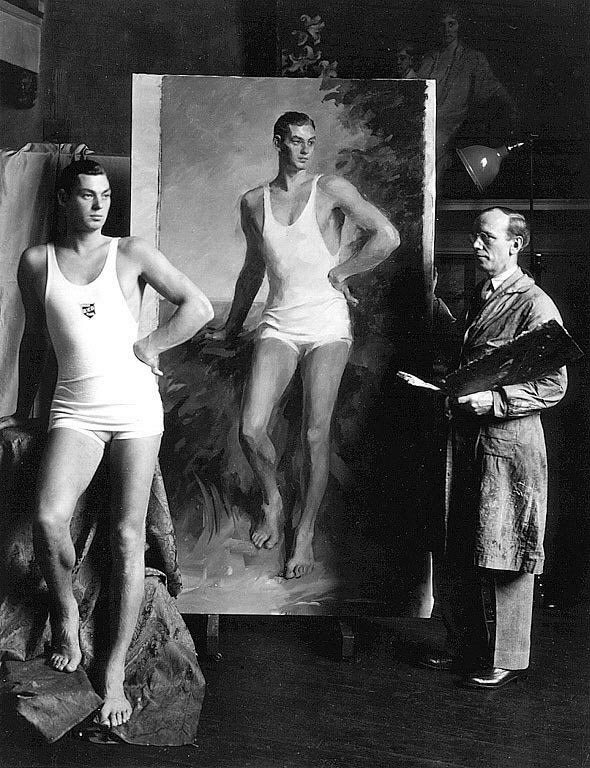Johnny Weissmuller: The Ape Man and “King of Swimmers”

Institution
By Catherine Baumgartner, Intern, Catalog of American Portraits, National Portrait Gallery
Johnny Weissmuller (1904–1984) captivated the American public with his dual Olympic-Hollywood celebrity status, making him one of the most unusual and impressive stars of the twentieth century. He was the champion athlete of the Paris 1924 Olympics, medaled in two sports (water polo and swimming), set unprecedented world swimming records, and earned more gold medals (five) than any previous swimmer. In public memory, however, he will always be remembered as MGM’s Tarzan the Ape Man (Streible).
Born in Friedorf, Austria-Hungary, Weissmuller moved to Windber, Pennsylvania, as an infant, and then to Chicago. The accounts of his early childhood are so conflicting that his citizenship was officially questioned when he qualified for the 1924 Olympic team; he used his brother’s Pennsylvania baptismal records to obtain a U.S. passport. According to Weissmuller’s son, he essentially exchanged identities with his brother Peter, a secret they took to their graves. Their switch was accepted without further question, and the city of Windber even granted him a “Delayed Certificate of Birth for Petrus John Weissmuller” in 1950.
On learning to swim, Weissmuller once said, “I can’t really explain it except to say that it was like coming home. I had found my element. Hell, for me it was easier to learn than walking.” He developed, and became famous for, his own “awkward” swimming style called the “six-beat-double-Trudgen crawl stroke” (Weissmuller, 29, 34).
He is often credited with expanding the appeal and fan-base of swimming. During his athletic career he swam distances from fifty yards to a half mile, all while setting fifty-one individual world records, becoming the first person to swim 100 meters in less than a minute and 400 meters in less than five (Streible).
Although the impressiveness of these accomplishments may wane in comparison to Mark Spitz’s nine gold medals and Michael Phelps’s eighteen, according to the Olympic Movement, some experts still regard him as the greatest swimmer of all time. They cite the limited availability of events during his time and his unmatched superiority over his rivals.

c. 1924 / National Portrait Gallery, Smithsonian Institution
Weissmuller’s athletic stardom was all but forgotten after he became Tarzan. He signed with BVD as a celebrity representative before joining with the film powerhouse MGM (Streible). He is pictured here modeling the BVD swimwear line, which he traveled cross-country to promote. At a hotel on one of these trips, Weissmuller befriended a little boy and taught him to swim. The boy was mysteriously accompanied by two big, well-dressed men at all times. Shortly after the little boy left the hotel, a package was delivered to Weissmuller with an expensive watch and a note that read: “Thanks for taking care of my son. —Al Capone” (Weissmuller, 53).
Through MGM he met Lupe Velez, a Mexican-born actress (Weever). In all he had five wives, but his relationship with Velez sparked the most gossip. They married in Vegas and were known for their fiery altercations. In one notorious outburst, Weissmuller chased Velez around an exclusive London hotel half-dressed, while the Queen of Holland cheered him on (Weissmuller, 80–81).
Weissmuller starred in twelve Tarzan movies before continuing with the “Jungle Jim” series and a succession of jungle action films (Streible). The cry of Tarzan and the line “Tarzan, Jane” (historically mistaken as “Me Tarzan, you Jane”) are now film legend (Weissmuller, 58–60). His yell was so famous that its origins were heatedly debated. Weissmuller claimed that it was derived from childhood family yodeling contests, but actually the cry was comprised of an electronic combination of his voice with other sounds (Weissmuller, 31-32). Weissmuller learned to perfectly imitate this Hollywood product, which he performed all over the world for eager fans.
His Olympic achievements were remembered in 1983, when he was elected as one of twenty-one charter members and teams for Team U.S.A.’s Olympic Hall of Fame. He passed away the following January in Acapulco, Mexico, close to the set location of his last Tarzan movie (Streible). When he died, his Tarzan yell was played in Moscow’s Red Square for a straight twenty-four hours, a memorial service that Tarzan himself certainly would have approved (Weissmuller, 118).
Cited:
“Class of 1983: Charter Class Inductees,” Team U.S.A., http://www.teamusa.org/About-the-USOC/Hall-of-Fame/Distinguished-Members/Class-of-1983.aspx, accessed July 31, 2012.
“Johnny Weissmuller: Olympic Tarzan,” Olympic.org: Official
Website of the Olympic Movement, http://www.olympic.org/johnny-weissmuller, accessed July 31, 2012.
Dan Streible, “Johnny Weissmuller.” American National Biography Online, http://www.anb.org/articles/18/18-01851.html, accessed July 31, 2012.
Andrea Weever, “Lupe Velez.” American National Biography Online, http://www.anb.org/articles/18/18-03585.html?a=1&n=lupe%20velez&d=10&ss=0&q=1, accessed July 31, 2012.
Johnny Weissmuller Jr., William Reed, and W. Craig Reed, Tarzan My Father (Toronto: ECW Press, 2002).